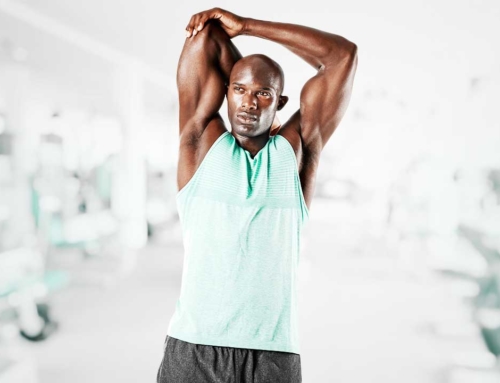In the general population, I’d argue that at least 90% have some sort of hip limitation. I can’t stress enough that sitting is destroying our hips and spine.
Here’s a typical day for the average Joe and Jane:
- Wake up, rush out for work and sit in a car for 45 minutes in traffic
- Get to the office, sit at a desk for 8–10 hours
- Finish the day, get back into the car to drive for another 45 minutes
- Arrive home and have dinner, sitting at the table
- Finish off the night by watching Netflix SITTING on the couch
- And repeat
Kyphotic Spines
When you begin to audit your day, you start to realize that the majority of your day is continually sitting. With this repetitive sequence, your body will adapt in two ways: biomechanically and neurologically.
From a biomechanics standpoint, the moment you place your body under stress, it will adapt. Sitting all day might not seem like gruelling stress like having anxiety before a presentation or finishing an intense HIIT workout, but, our bodies are designed for survival, which means we need to adapt. After years of sitting our spines will adopt a kyphotic curve. Kyphosis is when the spine rounds forward and can cause back pain. 20–30 years ago having a kyphotic spine was only common in the older population in women who also had osteoporosis, but now, because our culture sits ALL day we are seeing more and more people developing kyphotic spines.
Having a kyphotic spine also puts you in the risk of compression fractures in the spine. With the rounding posture, the vertebral discs are not stacked upon each other like a column, but rather more wedge-shaped. Ultimately this posture will cause problems down the road and could open a host of other issues as well.

So-called “bad posture” is also due to the surrounding muscles and fascia that create a tone that prevents us from proper movement. Muscle tone is the continuous and passive partial contraction of the muscles or the muscle’s resistance to passive stretch during resting state. An example of this is if we suddenly pull or stretch our muscles, the body responds by automatically increasing the muscle’s tension, a reflex which helps guard against danger as well as helping maintain balance. Such near-continuous innervation can be thought of as a “default” or “steady state” condition for muscles.
This innervation of our muscles increases when we limit our range of motion daily by sitting. An example of this is when you were younger and able to touch your toes, the fact that you’ve been sitting for so long your muscles have now adapted to the limited range of motion. The moment you go and try to touch your toes your muscles turn on that “tone” to prevent and guard you against so-called “danger.”
Fascia & Neurological Implications
Fascia is the second layer to this. Fascia is a band or sheet of connective tissue, primarily collagen, beneath the skin that attaches, stabilizes, encloses, and separates muscles and other internal organs. With this in mind, fascia surrounds our body head to toe, and fascia loves movement. Our bodies are designed for movement, and the moment we stop, the fascia reacts. Sticky adhesions form between fascial surfaces that aren’t regularly moved, and over time these adhesions get strong enough to inhibit range of motion. With more movement, foam rolling, and stretching our fascial adhesions will dissipate and we will end up with more range of motion.
The third and final layer that I look at is the neurological standpoint. Our nervous system is built to keep us alive and from harm. Our bodies continuously look for a state of homeostasis, so whatever we do with our bodies day to day over and over again that becomes our norm. Think about it, all of us were able to deep squat at one point of our lives, and out of nowhere, that ability disappears.
Why? The lame joke “if you don’t use it, you lose it” applies here. When we stop utilizing specific abilities of our bodies our nervous system goes “you haven’t deep squatted in years since that’s an energy-sucking movement, I want to preserve that energy, so you don’t die.” Then, viola, your ability to squat low is taken away, but you most likely haven’t realized it as you haven’t squatted in years anyway. It’s not until the general population end up back at the gym over several years in the first time and begin to realize all of their limitations.
Now imagine, you’re sitting at your desk hunched over for a decade or two with no physical activity, your body’s nervous system will slowly chip away at your mobility and stability abilities. After some time you’ll get “stuck.” What can you do to get back the mobility in your hips you had before? Start doing daily CARS, PAILS, and RAILS, and some active range lift offs and holds to ask your nervous system for all of it back politely!
Daily CARS, PAILS, And RAILS
CARS — Controlled Articular Rotations
1. Standing Hip CARS
2. Quadrupled Hip CARS
PAILS and RAILS
1. 90/90 Hip External Rotation PAILS and RAILS
2. 90/90 Hip Internal Rotation PAILS and RAILS
Active Range Lift-Offs and Holds
1. 90/90 Hip Internal Rotation Lift Offs
2. Seated Hip External Rotation Active Range Hold
By following these exercises daily, you’ll start to notice better functioning hips, and less aches and pains. Want to learn more about your hips, or any joint? Book your Functional Movement Screen with Coach Emily or Raf today!









Leave A Comment